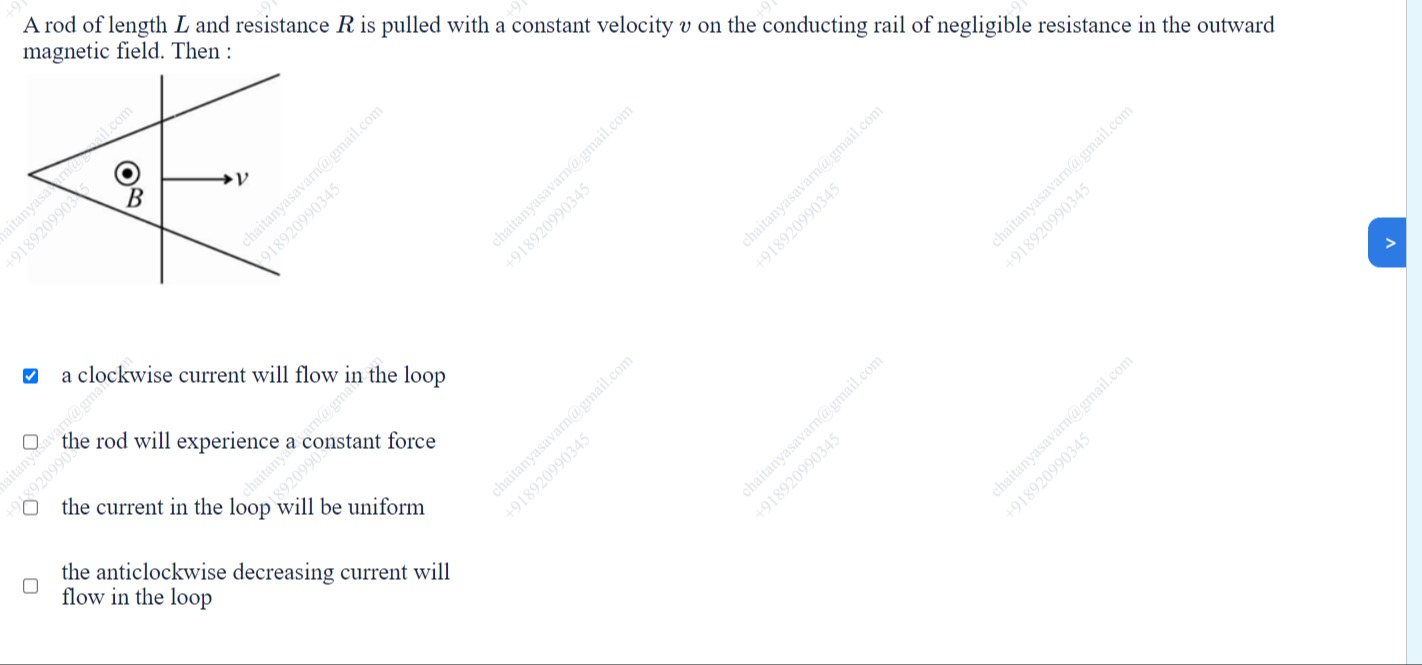Question
Question: A rod of length $L$ and resistance $R$ is pulled with a constant velocity $v$ on the conducting rail...
A rod of length L and resistance R is pulled with a constant velocity v on the conducting rail of negligible resistance in the outward magnetic field. Then :

a clockwise current will flow in the loop
the rod will experience a constant force
the current in the loop will be uniform
the anticlockwise decreasing current will flow in the loop
a clockwise current will flow in the loop
Solution
The problem describes a rod of length L and resistance R pulled with a constant velocity v on conducting rails of negligible resistance in a uniform outward magnetic field B. The rails are diverging, forming a wedge shape. The rod is moving horizontally. The diagram shows the rod oriented vertically, perpendicular to the direction of motion. This means the length of the rod in contact with the rails is the distance between the rails at the position of the rod. Let's assume the vertex of the rails is at the origin, and the rails are given by lines y=±xtanθ. If the rod is at a distance x from the vertex, its length between the rails is L(x)=2xtanθ. The rod is moving with velocity v, so x=vt (assuming x=0 at t=0). Thus, the length of the rod in contact with the rails is L(t)=2vttanθ.
The area of the loop formed by the rod and the rails is the area of the triangle with base L(t) and height x. The area is A(t)=21×base×height=21L(t)x=21(2vttanθ)(vt)=(vt)2tanθ. The magnetic flux through the loop is ΦB=BA(t)=B(vt)2tanθ. The induced EMF is E=−dtdΦB=−dtd(B(vt)2tanθ)=−B(2vttanθ)v=−2Bv2ttanθ. The magnitude of the induced EMF is ∣E∣=2Bv2ttanθ.
The induced current in the loop is I=R∣E∣=R2Bv2ttanθ.
Now, let's determine the direction of the induced current using Lenz's law. The magnetic field is outward. As the rod moves to the right, the area of the loop increases, so the outward magnetic flux increases. To oppose this increase, the induced current must create an inward magnetic field. By the right-hand rule, a clockwise current in the loop creates an inward magnetic field. Therefore, a clockwise current will flow in the loop.
Let's examine the options:
- a clockwise current will flow in the loop. This is consistent with our finding.
- the rod will experience a constant force. The force on the rod is F=IL(t)B (since the rod is perpendicular to the velocity and magnetic field). F=(R2Bv2ttanθ)(2vttanθ)B=R4B2v3t2tan2θ. This force depends on time t, so it is not constant.
- the current in the loop will be uniform. The current I=R2Bv2ttanθ depends on time t, so it is not uniform (constant).
- the anticlockwise decreasing current will flow in the loop. We found the current is clockwise and increasing with time.
Based on the analysis, the only correct statement is that a clockwise current will flow in the loop.
